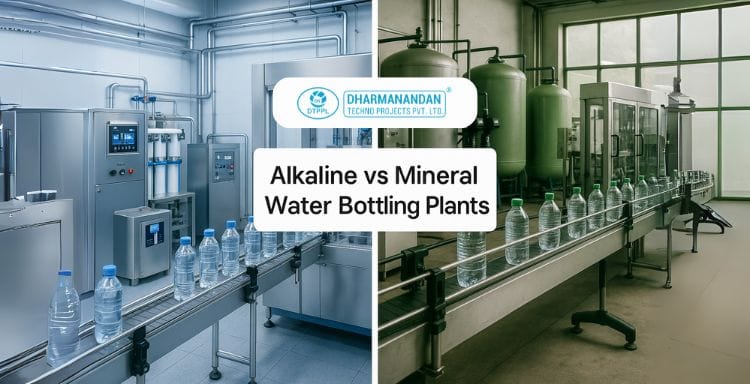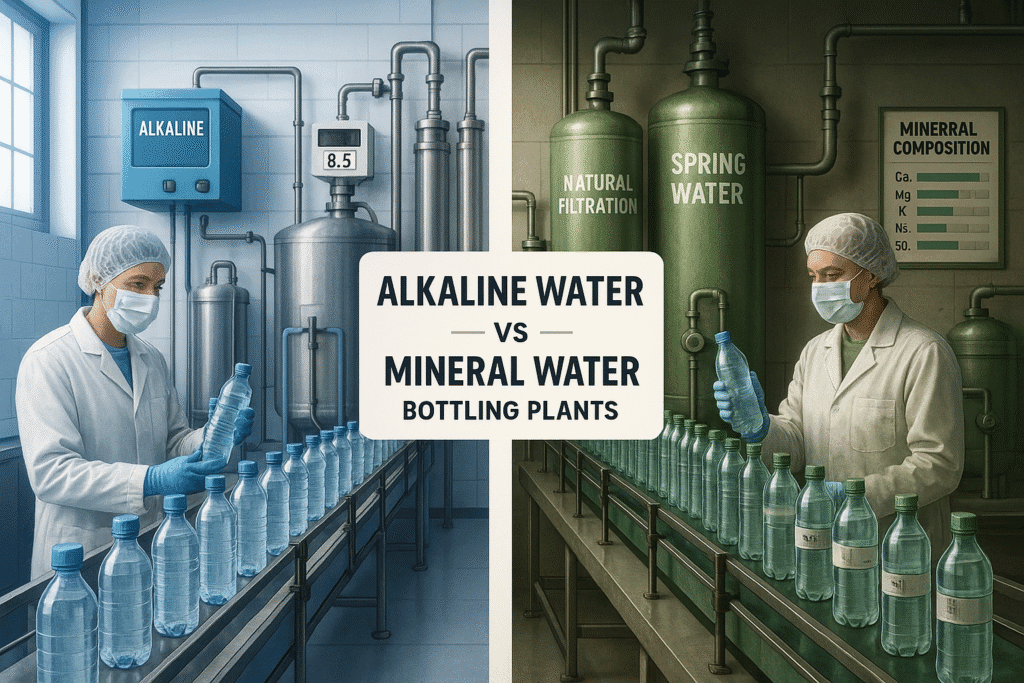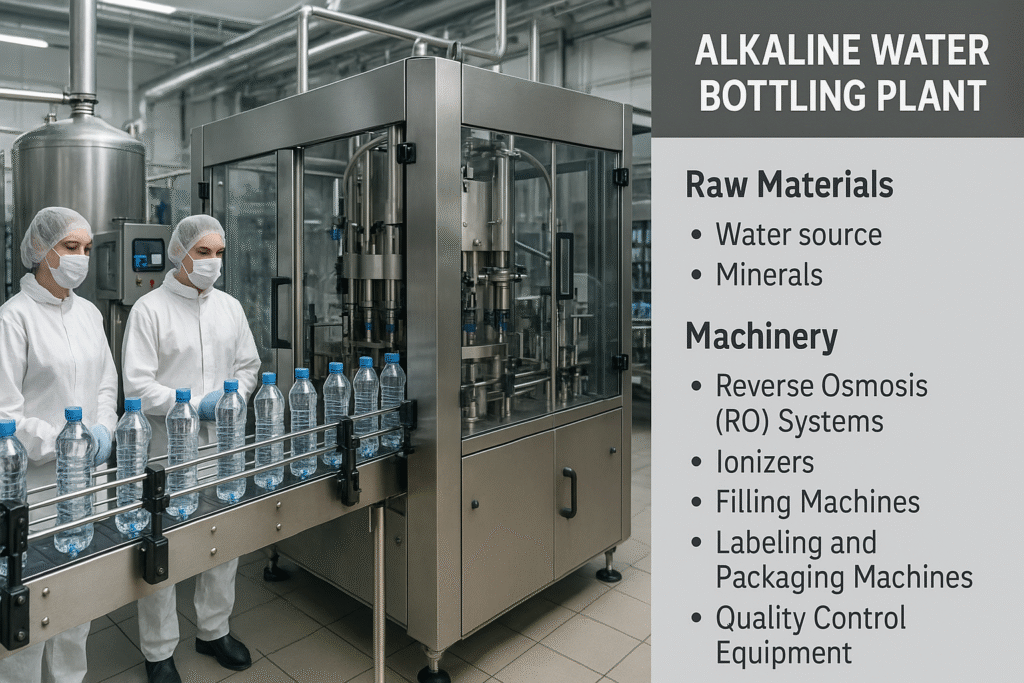
Table of Contents
Alkaline and Mineral Water Bottling Plants – What is Difference?
August 6, 2025
In the growing world of bottled water, two popular categories that have gained attention are alkaline water and mineral water. Both types offer unique benefits, and their production requires distinct processes. As health-conscious consumers continue to seek out beverages that promise hydration and wellness benefits, the demand for alkaline and mineral water has increased substantially. This article will explore the key differences between alkaline water and mineral water bottling plants, while also covering related topics like business potential, machinery, and challenges in the industry.
What is the Difference Between Alkaline Water and Mineral Water Bottling Plants?
Alkaline Water Bottling Plant
An alkaline water bottling plant focuses on producing water with a higher pH level, typically between 8.5 to 9.5, compared to regular drinking water (which has a neutral pH of around 7). The plant uses processes like reverse osmosis (RO), followed by ionization, to increase the pH and infuse the water with beneficial minerals like calcium, magnesium, and potassium.
Key processes involved in an alkaline water bottling plant include:
- Water purification using RO and other filtration methods.
- pH level adjustment using ionizers or alkaline mineral cartridges.
- Mineral infusion to achieve the desired taste and health benefits.
- Bottling and packaging using automated machinery for hygiene and efficiency.
Mineral Water Bottling Plant
A mineral water bottling plant produces water that naturally contains essential minerals like calcium, magnesium, sodium, and potassium. The water source could be from underground reservoirs, springs, or natural mineral-rich areas, and it undergoes minimal treatment to retain its mineral content.
Key processes involved in a mineral water bottling plant include:
- Sourcing water from natural springs or deep wells.
- Filtration to remove any contaminants while preserving the mineral content.
- Bottling and packaging for distribution.
The main difference lies in the mineral content and pH level-mineral water maintains its natural composition, while alkaline water is specifically processed to achieve higher pH and enhanced mineral infusion.

Profit Margin & ROI Analysis of Alkaline Water Bottling Business
The alkaline water bottling business has become a lucrative opportunity in India and globally due to the rising health consciousness. The profit margins for alkaline water are typically higher than regular bottled water, driven by its premium pricing, health benefits, and growing demand.
Profit Margin
- High margin potential: Alkaline water commands a premium price due to its perceived health benefits and specialized production process.
- Initial costs: The investment for setting up an alkaline water bottling plant ranges from INR 40 lakhs to INR 90 lakhs depending on the scale of the operation.
- Raw materials: The cost of minerals and water purification technologies (like RO systems, ionizers, etc.) can impact margins, but efficient operations and scaling can maximize returns.
ROI (Return on Investment)
- Long-term profitability: The ROI of an alkaline water plant typically improves over time as brand recognition and demand increase.
- Market growth: The market for alkaline water is expected to grow steadily due to the increasing health-conscious population, resulting in better sales volumes and higher profits.
In summary, while the initial investment may be high, the growing market for alkaline water presents a strong ROI potential over the long term.
Read Our Article: ROI Water’s Mineral Water Plant - Tapped from Slovenias Depths
Demand for Alkaline Bottled Water in Indian and Global Markets
The demand for alkaline water has been rising globally, driven by increasing awareness of its potential health benefits such as enhanced hydration, balancing the body’s pH, and detoxification. In India, this trend is gaining momentum as consumers look for healthier alternatives to sugary drinks and regular bottled water.
Indian Market
- Health trend: The rise in health-consciousness among Indian consumers has led to an increased demand for premium water products like alkaline water.
- Urbanization and disposable income: As disposable incomes rise, more people are willing to pay a premium for health-oriented products like alkaline water.
Global Market
- Rising awareness: The global market is seeing a shift towards healthier beverages, with countries like the USA, Japan, and European nations witnessing strong demand.
- Health-conscious population: As consumers in developed countries prioritize health, the demand for products like alkaline bottled water continues to grow, particularly among athletes and wellness-focused individuals.
Raw Materials and Machinery Required for Alkaline Water Bottling Plant
Raw Materials:
- Water source: The most important raw material is clean water, which can be sourced from wells, borewells, or other reliable sources.
- Minerals: Calcium, magnesium, and potassium are added to achieve the desired pH and health benefits in alkaline water.
Machinery:
- Reverse Osmosis (RO) Systems: For purifying water and removing impurities.
- Ionizers: To adjust the pH level of the water.
- Filling Machines: For bottling water efficiently and maintaining hygiene.
- Labeling and Packaging Machines: To create attractive packaging and ensure product quality.
- Quality Control Equipment: To ensure the product complies with FSSAI, BIS, and other regulatory standards.

How pH Level Adjustment Works in Alkaline Water Bottling Plants
The process of pH adjustment in alkaline water bottling plants typically involves ionization. Here’s how it works:
- Reverse Osmosis (RO): Water is first purified using RO, which removes contaminants and minerals.
- Ionizer: The purified water is then passed through an ionizer that uses electrolysis to increase the pH level, making it more alkaline.
- Mineral Infusion: Essential minerals like calcium and magnesium are added to improve taste and health benefits while maintaining the desired pH level of 8.5 to 9.5.
Challenges and Solutions in Running an Alkaline Water Bottling Plant
Running an alkaline water bottling plant comes with several challenges:
- Initial investment: The setup costs for machinery, land, and infrastructure can be high.
- Regulatory compliance: Complying with FSSAI, BIS, and other standards requires constant monitoring and quality control.
- Water source reliability: Ensuring a consistent supply of clean water is critical, as it affects product quality and production efficiency.
Solutions:
- Automation: Implementing semi-automatic or fully automated production systems can reduce operational costs.
- Government support: Taking advantage of subsidies for SMEs and regulatory incentives can ease financial burdens.
Alkaline Water Bottling Plant Automation: Latest Technologies & Trends
Recent advancements in automation have enhanced the efficiency of alkaline water bottling plants:
- Automated filtration systems: Ensuring efficient and consistent purification.
- Robotic packaging: Improving efficiency and reducing human errors in the bottling process.
- AI integration: Some plants use artificial intelligence for real-time monitoring of pH levels, mineral infusion, and overall water quality.
Role of Reverse Osmosis and Mineral Injection in Alkaline Water Bottling
- Reverse Osmosis (RO) plays a crucial role in purifying water and ensuring that impurities, bacteria, and harmful substances are removed.
- Mineral injection is necessary for adding beneficial minerals to achieve the required pH and improve water quality, ensuring that it is both alkaline and rich in essential minerals like calcium and magnesium.
FSSAI & BIS Guidelines for Alkaline Water Bottling Businesses
Both FSSAI (Food Safety and Standards Authority of India) and BIS (Bureau of Indian Standards) set guidelines for bottling and packaging alkaline water to ensure safety and quality:
- FSSAI: Ensures the quality and safety of bottled water, regulating aspects like hygiene, packaging, and labeling.
- BIS: Defines standards for drinking water, including permissible limits for contaminants, and sets specifications for packaging and storage.
Read Our Article: How to Get ISI (BIS) and FSSAI License for a Mineral Water Plant?
Environmental Impact & Sustainable Practices in Alkaline Water Bottling
The environmental impact of bottling plants can be significant, particularly in terms of plastic waste. However, many companies are adopting sustainable practices:
- Eco-friendly packaging: Moving towards recycled PET or biodegradable bottles.
- Water conservation: Efficient water use in the purification process.
- Energy-efficient machinery: Implementing energy-saving technologies to reduce the carbon footprint.
Export Opportunities for Alkaline Bottled Water from India
India has a strong potential to become a significant exporter of alkaline bottled water due to its growing production capacity and increasing demand worldwide. Exporting to countries like the USA, Middle East, and European markets can bring substantial revenue opportunities for Indian manufacturers.
Conclusion
The alkaline water bottling business is a growing industry with significant opportunities, driven by consumer health trends and technological advancements. Understanding the differences between alkaline and mineral water bottling, the essential machinery and raw materials, and the regulatory requirements are crucial for setting up a successful plant. While challenges exist, such as high initial costs and market competition, the potential for high profit margins and the growing demand for health-oriented products make it a promising venture in India and globally.

Director – Global Marketing and Sales
Mr. Bhavesh from Dharmanandan Techno Projects Pvt. Ltd. has played a pivotal role in elevating the DTPPL brand to the global stage, leveraging his exceptional expertise in marketing and communications. He is committed to helping clients achieve significant growth while strengthening their own brands. Dharmanandan Techno Projects Pvt. Ltd. is a leading manufacturer and supplier of water purification systems and turnkey solutions for mineral water plants. With years of experience in designing and delivering high-quality water treatment solutions, the company provides end-to-end services, including system design, installation, maintenance, and ongoing support. Specializing in scalable and customizable water plants, DTPPL has successfully served industries worldwide, ensuring clean and safe drinking water across diverse applications.
